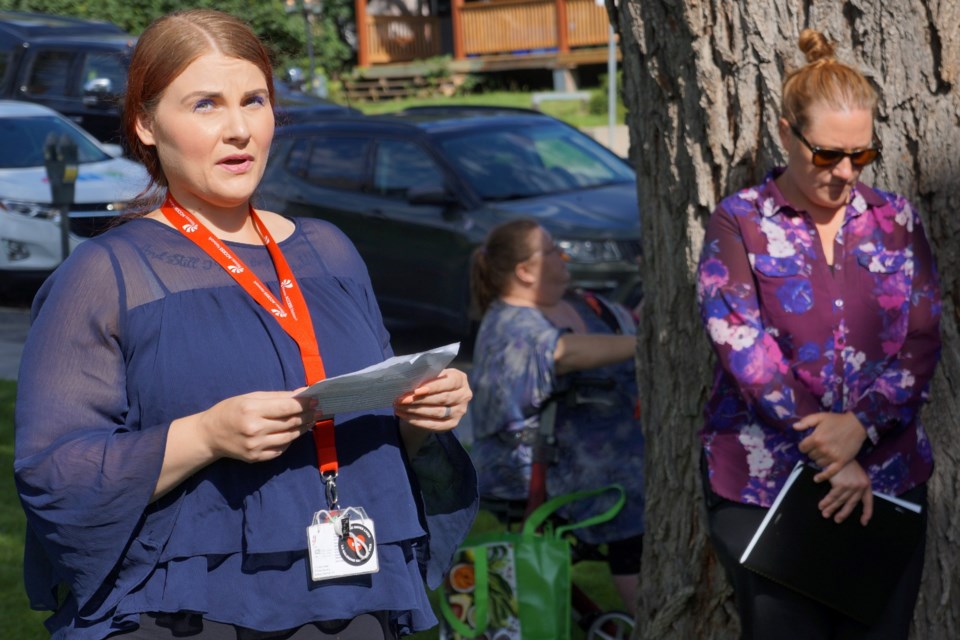More than 30 people gathered on the lawn of the Sudbury Jail today to honour the people who died unnatural or violent deaths while incarcerated.
Prisoners’ Justice Day is an annual observance hosted by The John Howard Society of Sudbury, Canadian Mental Health Association (Sudbury/Manitoulin), the Elizabeth Fry Society of Northeastern Ontario. It featured speeches, prayers, moments of silence and song.
It was also clear from speaker Aurora Stone, a woman with lived experience who now works in peer engagement for Reseau ACCESS Network, that the day should not only honour those who have been lost, but also those who are still suffering and dying.
Stone was incarcerated in Hamilton’s Barton Street Jail – formerly known as the Hamilton-Wentworth Detention Centre – for approximately one year beginning in 2015. She told those attending today’s event there were five unnatural deaths in the jail when she was incarcerated.
One story that stuck with her was of a woman who came back from court with “substances,” i.e. drugs, hidden inside her. When those in custody are in the court process, they are kept in what Stone refers to as “lockdown.”
While all the cells were shut tight for the night, the cellmate of the woman who brought in drugs began screaming. Eventually, other prisoners understood she was screaming about something wrong with her cellmate and that she was begging for help.
“It took over half an hour of yelling and begging for any guards to come, and then they just told us to shut up,” Stone recalled. “And then it took another 10 or 15 minutes before they even opened the cell door, because they waited for more guards and a nurse to come. By the time they entered the cell, the young woman had overdosed fatally and was deceased.”
While she attributes some of the issues to the corrections system’s perpetual lack of resources and staffing, as well as the absence of harm reduction practices, she said it is also the denial of rights of those who are incarcerated, and the lack of awareness, care and support from the community.
Stone told Sudbury.com that much of the care from corrections staff is based on the “behaviour” of those in custody, and that good versus bad behaviour is arbitrary.
“Good behavior isn't really good behavior,” she said. “It's more you didn't annoy a guard, you ratted somebody out, you did something that made a guard feel happy about you.”
Stone said the treatment of those in custody is debilitating, and that trauma continues after release.
“I hear people talk about all the time, how much help there is, how much counselling and how there's this and that, but that doesn't happen. It's not real. That's just a fantasy that everyone wishes were true,” she told Sudbury.com. “Most of the people that are in jail are getting tortured and punished with isolation.”
It was not only an awful time for her, as was clear in her retelling, but as she told Sudbury.com, that trauma stays with her today.
“You hear all these stories about it being people who deserve to be in there (in custody), but that's not the case. I know a lot of women and men who didn't get sentenced yet, they weren't found guilty, but because they had nobody to bail them out of jail, or they didn’t look good enough in court, they had to stay there until their trial,” Stone said.
”There's people in jails who are subjected to torture when they have not been found guilty of a crime; what become death sentences when they have not been found guilty of a crime.”
John Howard Society of Sudbury’s CEO Sara-Jane Berghammer told Sudbury.com trauma is often the reason people find themselves in custody that they are often re-traumatized because of the jail’s only real tools in controlling people who are incarcerated: isolation and segregation.
“Though over the years, there have been some significant training and support for correctional officers in relation to mental health, they are not mental health professionals and jails are not equipped properly to deal with the vast number of people having mental health and significant concerns, because the only tools that they really have are isolation, segregation, isolation,” Berghammer said.
And because the health care of those in custody is overseen by Corrections Services, rather than the Ministry of Health, the focus is on “care and control,” Berghammer said, rather than overall health, and especially, mental health.
There is also the need to focus on the opioid crisis within custody walls, Berghammer said, not only due to the prevalence of substance-use issues, but the toxicity of those substances.
“We know that substances have been in the jails for many years, that's not something that is uncommon; but the level of toxicity of those substances is definitely a problem and the level of addiction to hard substances is very concerning and very, very challenging to combat,” she said.
In order to create real change within the prison systems, Stone said there needs to be a vast improvement to the medical and mental health care services and support, as well as acknowledging and addressing the relationship between corrections officers and the populations they work with.
“Start focusing on rehabilitation and reunification with society and work with parole boards to accelerate release processes, then, maybe a prison sentence would not become a death sentence for so many,” Stone said.
“That is what today symbolizes for me, standing in solidarity and showing the community that every individual incarcerated today along with every person whose life ended needlessly; we care, we see you, we hear you and we will continue to do the work necessary to bring about change.”
Jenny Lamothe is a reporter with Sudbury.com. She covers the diverse communities of Sudbury, especially the vulnerable or marginalized, including the Black, Indigenous, newcomer and Francophone communities, as well as 2SLGBTQ+ and issues of the downtown core.
